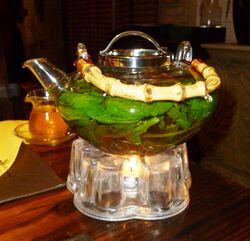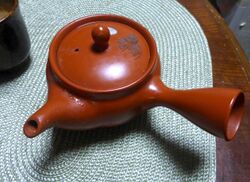Engineering:Teapot
A teapot is a vessel used for steeping tea leaves or a herbal mix in boiling or near-boiling water, and for serving the resulting infusion which is called tea. Dry tea is available either in tea bags or as loose tea, in which case a tea infuser or tea strainer may be of some assistance, either to hold the leaves as they steep or to catch the leaves inside the teapot when the tea is poured. Teapots usually have an opening with a lid at their top, where the dry tea and hot water are added, a handle for holding by hand and a spout through which the tea is served. Some teapots have a strainer built-in on the inner edge of the spout. A small air hole in the lid is often created to stop the spout from dripping and splashing when tea is poured. In modern times, a thermal cover called a tea cosy may be used to enhance the steeping process or to prevent the contents of the teapot from cooling too rapidly.
History
The teapot was invented in China during the Yuan Dynasty. It was probably derived from ceramic kettles and wine pots, which were made of bronze and other metals and were a feature of Chinese life for thousands of years. Tea preparation during previous dynasties did not use a teapot.[1] In the Tang Dynasty, a cauldron was used to boil ground tea, which was served in bowls. Song Dynasty tea was made by boiling water in a kettle then pouring the water into a bowl with finely ground tea leaves. A brush was then used to stir the tea. Written evidence of a teapot appears in the Yuan Dynasty text Jiyuan Conghua, which describes a teapot that the author, Cai Shizhan, bought from the scholar Sun Daoming. By the Ming Dynasty, teapots were widespread in China.[1] The earliest example of a teapot that has survived to this day seems to be the one in the Flagstaff House Museum of Teaware; it has been dated to 1513 and is attributed to Gongchun.[2]
Early teapots are small by western standards because they are generally designed for a single drinker, and the Chinese historically drank the tea directly from the spout. The size reflects the importance of serving single portions so that the flavours can be better concentrated and controlled, then repeated.[3]
From the end of the 17th century tea was shipped from China to Europe as part of the export of exotic spices and luxury goods. The ships that brought the tea also carried porcelain teapots. The majority of these teapots were painted in blue and white underglaze. Porcelain, being completely vitrified, will withstand sea water without damage, so the teapots were packed below deck whilst the tea was stowed above deck to ensure that it remained dry.[4]
Tea drinking in Europe was initially the preserve of the upper classes, due the expense. Porcelain teapots were particularly desirable because porcelain could not be made in Europe at that time. It wasn't until 1708 that Ehrenfried Walther von Tschirnhaus devised a way of making porcelain in Dresden, Germany, and started the Meissen factory in 1710.[5] When European potteries began to make their own tea wares they were inspired by the Chinese designs.
In colonial America, Boston became the epicenter for silver production and artistry. Among the many artists in Boston there were four major families in the city's silver market: Edwards, Revere, Burt and Hurd. Their works of art included silver teapots.[6]
Heat retention
To keep teapots hot after tea is first brewed, early English households employed the tea cosy, a padded fabric covering, much like a hat, that slips over the tea pot. Often decorated with lace or log cabin motifs in the early 1900s, the modern tea cosy has come back into fashion with the resurgence of loose leaf tea ateliers. [citation needed]
Chocolate teapot
A chocolate teapot is a teapot that would be made from chocolate. It is commonly supposed that such a teapot would melt, and be impossible to use, therefore the term is often used as an analogy for any useless item.
Experimental researchers in 2001 did indeed fail to successfully use a chocolate teapot they had made.[7] Later research, however, by The Naked Scientists in 2008, showed that such a teapot could be used to make tea, provided that the walls of the teapot were more than one centimetre thick.[8] Re-usable (for a limited number of times) pots are now easily available online.
In non-teamaking contexts
A teapot has a rather distinctive shape, and its fame may sometimes have little to do with its primary function.
- The Utah Teapot is a standard reference object of the computer graphics community, comparable to Hello, World for its popularity. It is included as a graphics primitive in many graphics packages, including AutoCAD, POV-Ray, OpenGL, Direct3D, and 3ds Max.
- Russell's teapot, is an analogy, devised by Bertrand Russell, which attacks the unfalsifiability of religious claims, comparing them to the eponymous teapot. The concept in turn inspired the title of the 1973 album Flying Teapot by the Franco-British rock band Gong.
- The teapot has been featured in the American children's song from 1939, "I'm a Little Teapot".
- In Korea, the teapot is commonly used as a serving container for various types of wines.
- Part of the constellation of Sagittarius contains an asterism (or a star pattern not officially recognized as a constellation) that famously resembles a teapot.
- The 'Teapot Game' is a word game described by Mary White's Book of Games, and involves guessing a word which is replaced by "teapot" in various sentences.[9]
- The Teapot is a tale by Hans Christian Andersen.
In architecture
- In 2004, a Malaysian cult called the Sky Kingdom constructed a 35 foot tall, cream colored teapot, with an unusually long spout, higher than the pot itself on its property as part of its own private symbolism[10] which included a similarly large blue vase next to the teapot. As part of a crackdown on the sect in August 2005 bulldozers and heavy machinery were sent in to tear down the structure.
- The (purported) world's largest architectural teapot is to be found in West Virginia. In 1938 The Chester teapot was constructed by William "Babe" Devon. The Teapot started its life as a gigantic wooden hogshead barrel for a Hires Root Beer advertising campaign. Devon purchased the barrel in Pennsylvania and had it shipped to Chester, WV where it was set up at the junction of State Route 2 and U.S. Route 30. A spout and handle were added at this time and the wooden barrel was covered with tin to form the teapot's shape. A large glass ball was placed on top to make the knob of the "lid". The Teapot stood in front of Devon's pottery outlet store. Local teenagers were hired to run a concession and souvenir stand which was set up inside the Teapot.
- The Teapot Dome Service Station is located in Zillah, Washington. It was built in 1922, and the 15-foot handled-and-spouted gas station was designed as a visual pun referencing the then-current Teapot Dome scandal. It has been moved multiple times and is no longer an active gas station.[11]
See also
- Brown Betty, a type of British teapot made from a red clay, known for being rotund and glazed with brown manganese
- Cube teapot, a ruggedized teapot invented for use on ships
- ISO 3103
- Kettle, types of vessels specialized for boiling and pouring plain water, often metal, also with a spout, sometimes electric
- Kyūsu, a Japanese ceramic teapot, often with a side handle
- pot-holder
- Samovar, a heated metal container traditionally used to boil water for tea in and around Russia, as well as in other Slavic nations, Iran and Turkey
- Slop bowl
- Sparta Teapot Museum, formerly in Sparta, North Carolina, USA
- Teacup
- Tealight, a small candle originally used to keep a teapot warm
- Tea set, a typically matching set of dishes including a teapot for serving tea in a formal manner
- Tetsubin, Japanese cast iron pot with a spout
- Utah teapot, a 3D model of a teapot frequently used as a reference object in computer graphics
- Yixing clay teapot, a special Chinese clay teapot
References
- ↑ 1.0 1.1 Kuei-Hsiang Lo (1986). The Stonewares of Yixing: From the Ming Period to the Present Day. Hong Kong University Press. p. 18. ISBN 978-962-209-112-2. https://books.google.com/books?id=3zAP3tBBPEcC&pg=PA18. Retrieved 8 February 2013.
- ↑ Collecting teapots Leah Rousmaniere ISBN:0-375-72045-6
- ↑ "Archived copy". Archived from the original on 2011-03-23. https://web.archive.org/web/20110323234907/http://www.imperialteapots.com/servlet/the-template/guidetoyixingteapots/Page. Retrieved 2011-04-07.
- ↑ Teapots Paul Tippett ISBN:0-8212-2269-4
- ↑ Gleeson, Janet. The Arcanum, an accurate historic novel on the greed, obsession, murder and betrayal that led to the creation of Meissen porcelain. Bantam Books, London, 1998.
- ↑ Birmingham Museum of Art (2010). Birmingham Museum of Art : guide to the collection. [Birmingham, Ala]: Birmingham Museum of Art. p. 107. ISBN 978-1-904832-77-5. http://artsbma.org.
- ↑ "An Appraisal of the Utility of a Chocolate Teapot". Plokta. http://www.plokta.com/plokta/issue23/teapot.htm. Retrieved 2009-01-21.
- ↑ "How useless is a Chocolate Teapot?". Kitchen Science Experiments. The Naked Scientists. http://www.thenakedscientists.com/HTML/content/kitchenscience/exp/how-useless-is-a-chocolate-teapot/. Retrieved 2008-12-10.
- ↑ Mary White. "Teapot". The Book of Games. Charles Scribner's Sons, New York NY 1896. https://archive.org/stream/bookofgameswithd02whit#page/128/mode/2up. Retrieved 2015-03-17.
- ↑ "Sky Kingdom | Ayah Pin : Apologetics research resources". Apologeticsindex.org. http://www.apologeticsindex.org/s/s53.html#Subject2. Retrieved 2012-06-12.
- ↑ "Teapot". Cityofzillah.us. 2004-01-01. http://www.cityofzillah.us/teapot.html. Retrieved 2014-03-12.
Further reading
- Steve Woodhead, "The Teapot Book" A.&C. Black, 2005 ISBN:0-7136-6016-3.
- Robin Emmerson, "British Teapots and Tea Drinking" HMSO, 1992 ISBN:0-11-701509-1
- Garth Clark "The Artful Teapot" Thames and Hudson ISBN:0-500-51045-8
- Edward Bramah "Novelty Teapots" Quiller Press ISBN:1-870948-72-6
External links









